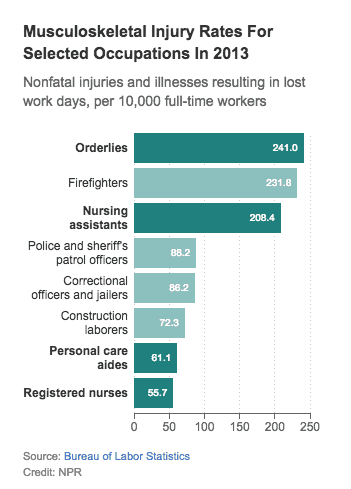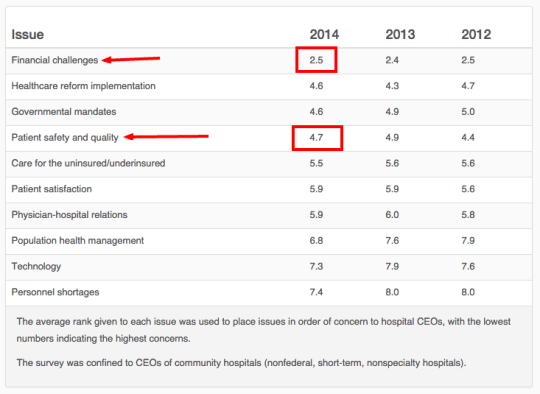It's really easy to make statements like “patient safety is our top priority.” That same statement can be applied to hospital staff, as well.
Or, it should.
But the “happy talk” (as Pascal Dennis calls it) isn't always followed up by action.
When a hospital executive makes the “safety is always our top priority” statement, is it REALLY true? Is that statement backed up by action and integrity or does it just sound good?
The top priority comment is predictably almost always present in any news story about a medical error.
Listen to Mark read the post (Learn More):
From some recent stories:
Palomar Health Takes Action to Resolve $50K Fine in Unattended Patient's Death
“In response, UC San Diego Health System submitted plans of correction to the California Department of Public Health which were accepted and implemented. We remain vigilant in training employees to communicate quickly and effectively with our hospital security team so that responses to patient needs are timely, with safety as the first priority.”
Mark Twain Medical Center fined $50,000 in 2013 death
Mark Twain Medical Center's statement on the matter, emailed by hospital spokeswoman Nicki Stevens, said “Patient care and safety is our top priority.”
Jewish General Hospital hampered by computer problems
“The hospital is doing its best to minimize inconveniences for its patients and visitors; moreover, there has been absolutely no compromise to patient safety, which is always the top priority of the JGH,” the hospital said in a news release issued Friday morning.”
Reported errors climb in area hospitals
Keeping in mind that an increase in “reported errors” doesn't mean that the actual occurrence of errors has increased. It could mean more honesty and more transparency.
“Patient safety is a top priority for our hospitals and we continually implement changes that result in significant improvements in patient care,” she said in a statement. “As part of our High Reliability Organization work recently, we have focused on encouraging staff to report any potential safety issues, which allows us to make improvements in our work and provide highly reliable care. “
So they admit that it hasn't ALWAYS been the top priority that staff haven't always been safe to speak up? Better late than never.
Area hospitals earn C grades in safety report
“Nancy Seck, director of quality management for Glendale Memorial, said in a statement that patient care and safety are the hospital's top priority and that doctors, nurses and caregivers work together to improve care every day.”
Improving together every day. That's the goal of Kaizen and some organizations have that culture. But, how does Glendale Memorial demonstrate that they are really improving every day? Do reporters press them on this? How can they demonstrate that they make safety a top priority over cost?
Sharing my view is Dr. Ashish Jha, professor of health policy at the Harvard School of Public Health and a top expert on patient safety:
“To be frank [safety] really isn't anyone's top priority — except maybe the patient,” Jha told me. Hospital CEOs generally don't get fired because of the hospital's infection rates. Salaries are tied to things like fundraising and having high-tech equipment. “There's no evidence that having a high infection rate or a high mortality rate has any effect on CEO salaries,” Jha said.
Compare this to the Toyota philosophy that safety is the gateway to all work. That's also a meaningless statement if it's not backed by action.
But, statistics show that manufacturing (even heavy industry) has done a better job of protecting employees from injury. Former ThedaCare CEO John Toussaint, MD pointed out that, at the start of their Lean journey, an employee at the hospital was more likely to get hurt than somebody working in a paper mill.
See this chart from a recent NPR story (which is a must read / must listen):

Whether it's patient safety or staff safety, leaders shouldn't make excuses about how these things are just bound to happen. We can do better – it's a combination of the right staffing levels, the right technology, and the right training… but is probably starts with the right leadership.
Hospitals are far too often not “walking the walk.” Even surveys of hospital executives show that they SELF REPORT that financial issues are more of a “top concern” than safety.

This is shameful. At least the spokespeople have figured out to SAY that patient safety is a top priority. But the CEOs don't. Some would say the CEOs think they have delegated safety to another leader. But, I think a Lean thinker would agree it's not possible to delegate safety or quality. Safety and quality starts at the top, as it does with ThedaCare's current CEO Dr. Dean Gruner, who I think sets a good example.
If I were to ask your hospital, “Tell me a story about a time recently where you demonstrated that safety really is the top priority, even over short term costs” — what stories would there be?
Come back Thursday as I'll share one hospital executive's story of a time safety was put first. I'd love to hear your stories. Post a comment below…
———-
Do you want to see what a “culture of continuous improvement” looks, sounds, and feels like? Check out this workshop (more of a mini conference) that Joe Swartz and I are holding in April at his health system in Indianapolis. Please come join us.
What do you think? Please scroll down (or click) to post a comment. Or please share the post with your thoughts on LinkedIn – and follow me or connect with me there.
Did you like this post? Make sure you don't miss a post or podcast — Subscribe to get notified about posts via email daily or weekly.
Check out my latest book, The Mistakes That Make Us: Cultivating a Culture of Learning and Innovation:










[…] I blogged recently about the need for hospitals to truly make safety a top priority (for nurses and patients). This NPR piece dives into some of the preventable harm that occurs for healthcare professionals: “Hospitals Fail To Protect Nursing Staff From Becoming Patients.” Again, talk about a lack of respect. […]
[…] easy for hospitals to say they “always make patient safety a top priority,” but we need to hear more stories about how hospitals actually live that every […]
[…] Or something like that. I don’t have a picture of it because taking photos while driving might lead to an visit to the emergency department (safety first!). […]
Thanks for bringing this up! One thing I noticed in some hospitals is that while their staff are, no doubt, highly skilled, they lack empathy and basic client care manners. It’s like you owe them for paying attention to you. This doesn’t apply to all, of course. Perhaps medical schools should give a little more time on GMRC (Good Manners and Right Conduct).
[…] teams are going to say “fan safety is our top priority” (much as hospitals do), how do you translate those words into […]
Here’s a news story that a blog reader from Australia sent:
“Fiona Stanley Hospital patients injured, not fed, left in dirty beds: review”
Read more: http://www.watoday.com.au/wa-news/fiona-stanley-hospital-patients-injured-not-fed-left-in-dirty-beds-review-20150723-giisbo.html#ixzz3giS8BNSg
After a long list of problems – wrong medications, wrong doses, patient falls, instruments not being sterilized properly… a professor says:
“patient care was always a top priority.”
Was it?
Was it really???
[…] It’s too easy for hospitals to say “patient safety is always our top priority” even when thatR…. […]
Ah, this danged phrase about patient priorities comes up again:
“UM among worst area hospitals on infections”
And my favorite empty-words expression comes up from Henry Ford:
Top priority? I guess not? Easier said than done?
How much time do the CEO and other senior leaders dedicate to helping solve this problem and providing leadership around this?
From a recent visit… slogans and t-shirts don’t improve quality.
[…] I hope this is true… if the principles are NOT “owned by everyone,” then an initiative like this might end up demoralizing the people it’s meant to help. I think “values” statements like this are noble and helpful, but leaders at all levels need to “walk the walk.” As I’ve written about before, if an organization is going to SAY they “make patient safety a top priority,” it canR…. […]
It would be nice if there was a paradigm shift from safety to patient care in the context of the Hippocratic Oath ” to do no harm ”
I would think that Deming might observe is patient care not safety.
AS to that lobby sign, I would turn around and leave.
Actually, “First do no harm” is not in the Hippocratic Oath.
https://en.wikipedia.org/wiki/Hippocratic_Oath
As Dr. John Toussaint has pointed out, the oath says the physician’s first duty is basically to respect and protect other physicians.
“First do no harm”is a idea in terms of medical ethics… but it’s too often lip service.
https://en.wikipedia.org/wiki/Primum_non_nocere
That phrase came up in this article:
“The health and safety of our patients continues to be our top priority and we take all allegations against our essential health-care delivery system very seriously,” an HHC spokeswoman said in response to the physician’s critique.”
http://nypost.com/2016/05/08/doctor-reveals-horrors-that-make-this-hospital-dangerous-for-kids/
Yet the article outlines understaffing, poor training, disorganization, etc. that allegedly harmed kids.
Enough of the lip service!